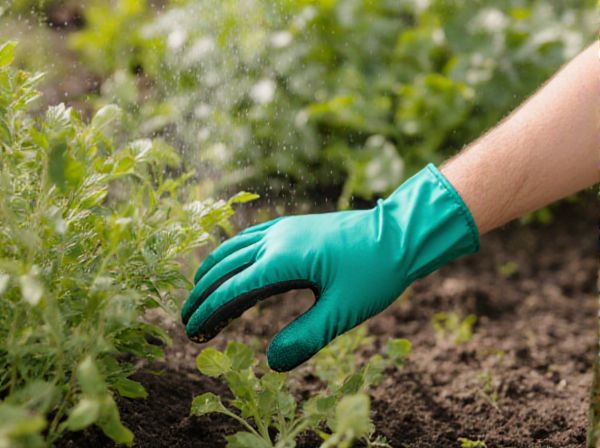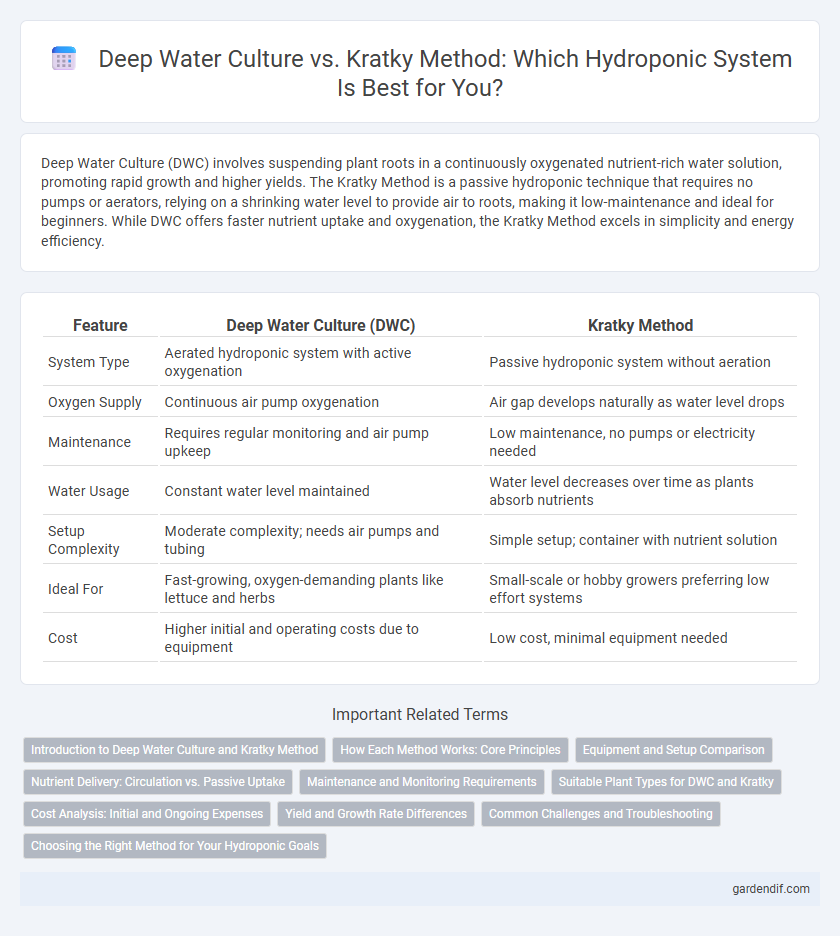
Deep Water Culture vs Kratky Method Illustration
Deep Water Culture (DWC) involves suspending plant roots in a continuously oxygenated nutrient-rich water solution, promoting rapid growth and higher yields. The Kratky Method is a passive hydroponic technique that requires no pumps or aerators, relying on a shrinking water level to provide air to roots, making it low-maintenance and ideal for beginners. While DWC offers faster nutrient uptake and oxygenation, the Kratky Method excels in simplicity and energy efficiency.
Table of Comparison
| Feature | Deep Water Culture (DWC) | Kratky Method |
|---|---|---|
| System Type | Aerated hydroponic system with active oxygenation | Passive hydroponic system without aeration |
| Oxygen Supply | Continuous air pump oxygenation | Air gap develops naturally as water level drops |
| Maintenance | Requires regular monitoring and air pump upkeep | Low maintenance, no pumps or electricity needed |
| Water Usage | Constant water level maintained | Water level decreases over time as plants absorb nutrients |
| Setup Complexity | Moderate complexity; needs air pumps and tubing | Simple setup; container with nutrient solution |
| Ideal For | Fast-growing, oxygen-demanding plants like lettuce and herbs | Small-scale or hobby growers preferring low effort systems |
| Cost | Higher initial and operating costs due to equipment | Low cost, minimal equipment needed |
Introduction to Deep Water Culture and Kratky Method
Deep Water Culture (DWC) is a hydroponic technique where plant roots are suspended in oxygen-rich nutrient solution, promoting rapid growth and efficient nutrient uptake. The Kratky Method is a passive hydroponic system that allows roots to grow suspended in nutrient solution without the need for pumps or aeration, making it low-maintenance and ideal for beginners. Both methods optimize water and nutrient use, but DWC emphasizes active oxygenation while Kratky relies on static nutrient levels.
How Each Method Works: Core Principles
Deep Water Culture (DWC) relies on suspending plant roots directly in a nutrient-rich, oxygenated water solution, ensuring constant nutrient and oxygen access via air pumps and aerators. The Kratky Method operates as a passive hydroponic system where plants grow in a nutrient solution with an air gap that forms as water levels drop, allowing roots to access both nutrient solution and atmospheric oxygen without external aeration. Both methods emphasize root immersion but differ fundamentally in oxygen delivery--active aeration in DWC versus natural diffusion in Kratky.
Equipment and Setup Comparison
Deep Water Culture (DWC) requires continuous aeration through air pumps, air stones, and water reservoirs to maintain oxygen levels for plant roots, making the setup more complex and equipment-intensive. The Kratky Method eliminates the need for pumps and electricity by using a static water reservoir with gradual nutrient depletion, resulting in a simpler, low-maintenance system ideal for small-scale or beginner hydroponic growers. Both methods rely on nutrient-rich water but differ significantly in oxygenation approach and hardware complexity, impacting initial costs and operational effort.
Nutrient Delivery: Circulation vs. Passive Uptake
Deep Water Culture (DWC) employs active nutrient delivery through continuous aerated water circulation, ensuring oxygen-rich, nutrient-dense solutions that promote rapid root absorption and growth. In contrast, the Kratky Method relies on passive nutrient uptake, where plants access nutrients from a static water reservoir that diminishes as roots grow, making it a low-maintenance system with slower nutrient replenishment. The choice between DWC's dynamic circulation and Kratky's passive approach significantly impacts plant growth rate, root oxygenation, and system management complexity.
Maintenance and Monitoring Requirements
Deep Water Culture (DWC) demands continuous aeration and frequent monitoring of oxygen levels, pH, and nutrient concentration to ensure optimal root health, requiring air pumps and timers for consistent oxygen delivery. The Kratky Method is a passive system that minimizes maintenance by eliminating the need for aeration, relying on a declining water level to provide roots with air, making it ideal for beginners or low-maintenance setups. Regular nutrient solution checks are essential in both methods, but DWC necessitates more active intervention to prevent root rot and maintain ideal growing conditions.
Suitable Plant Types for DWC and Kratky
Deep Water Culture (DWC) is ideal for fast-growing, oxygen-loving plants such as leafy greens like lettuce, spinach, and herbs including basil and mint due to its continuous oxygen supply and nutrient availability. The Kratky method suits low-maintenance plants like lettuce, Swiss chard, and some herbs, thriving without pumps or aeration as they benefit from a passive hydroponic system. Both methods efficiently support different plant types based on oxygen requirements and growth speed, with DWC favoring high-demand varieties and Kratky best for resilient, slower-growing crops.
Cost Analysis: Initial and Ongoing Expenses
Deep Water Culture (DWC) systems require higher initial investment due to pumps, air stones, and reservoirs, while the Kratky Method offers a low-cost, passive setup without electrical components. Ongoing expenses for DWC include electricity for aeration and periodic pump replacements, whereas the Kratky Method incurs minimal maintenance costs due to its simplicity and lack of moving parts. Cost efficiency favors the Kratky Method for beginners or small-scale growers seeking budget-friendly hydroponics, while DWC supports larger or continuous production with higher upfront expense.
Yield and Growth Rate Differences
Deep Water Culture (DWC) systems typically produce faster growth rates and higher yields due to continuous oxygenation and nutrient availability, promoting robust root development. In contrast, the Kratky Method, a passive hydroponic technique, offers slower growth rates and moderate yields because it relies on a stationary nutrient solution and limited oxygen supply. For commercial growers prioritizing maximum productivity, DWC remains the preferred choice, while the Kratky Method suits low-maintenance or small-scale cultivation with less intensive growth demands.
Common Challenges and Troubleshooting
Deep Water Culture (DWC) often faces challenges like oxygen depletion and root rot, which require regular monitoring of dissolved oxygen levels and maintaining water temperature between 65-75degF to prevent poor plant growth. The Kratky Method may encounter issues with nutrient depletion and insufficient aeration as plants mature, necessitating precise nutrient concentration adjustments and water level observations to ensure roots remain partially submerged and oxygenated. Both methods demand consistent pH control within the 5.5-6.5 range and vigilant observation for signs of nutrient deficiencies or algae growth for optimal plant health.
Choosing the Right Method for Your Hydroponic Goals
Deep Water Culture (DWC) offers continuous oxygen supply through an air pump, promoting rapid plant growth ideal for intensive production, while the Kratky Method requires no electricity, relying on a static nutrient solution ideal for low-maintenance setups. Selecting the right hydroponic method depends on goals such as crop yield, system complexity, and operational costs, with DWC suited for commercial growers and Kratky favoring beginners or hobbyists. Understanding factors like oxygenation needs, nutrient delivery, and maintenance frequency ensures optimal plant health and productivity in hydroponic systems.
Deep Water Culture vs Kratky Method Infographic

 gardendif.com
gardendif.com